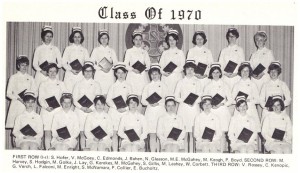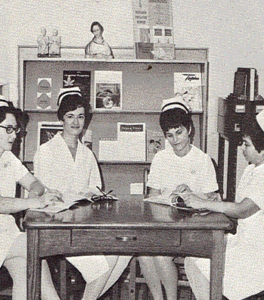45 Years After the Lorrain School of Nursing Transferred Nursing Education to Algonquin College
Posted on Wednesday, July 22nd, 2020
In the spring of 1975, the final graduating class from Pembroke’s Lorrain School of Nursing was celebrated. In a parting message to the more than 40 graduates the convocation booklet offered this passage, “Life is a dynamic and constantly changing process in which we must all change with the times. Gone is the day of the independent nursing school. Now our mode of education has changed to that of the Community College, in an effort to standardize and improve nursing education throughout the province. We are now known as Algonquin College Health Sciences Division-Lorrain.”
It was the end of an era. The Lorrain School of Nursing has been operating since 1916. It had been founded by Sister St. Elizabeth of the Catholic Church, operating out of the Pembroke General Hospital. In 1926, the school was transferred to the administration of the Grey Sisters of the Immaculate Conception, who continued to operate it until that final graduating class in 1975. In its 58 year history, the school turned out hundreds of nursing graduates, most of whom were hired to work in Pembroke’s two hospitals, the General and the Civic hospital which closed in the 1990s as part of Ontario’s hospital restructuring mandate.

The decision to move all nursing education into the fledging Ontario college system was not unexpected. It had been rumoured for some time and took hold when the architect of the province’s new college training system moved into the Premier’s seat at Queens Park.
Bill Davis had served as Premier John Robarts’ education minister. In the mid-1960’s he was tasked with overhauling the model of vocational schools that had existed in Ontario for many years and replacing them with a province-wide publicly funded network of Colleges that would support the training and re-training requirements of the province’s industries.
In 1967, the college system was founded with large urban colleges established in most of Ontario’s major cities, and many regional smaller campuses in geographical locations that could support a post-secondary institute. Pembroke was one of those communities, the campus becoming an extension of Algonquin College in Ottawa.

When Davis succeeded Robarts as Ontario’s Premier in 1971 he set his sights on bringing health care training into colleges, particularly nursing which for decades had been delivered through hospitals, divided on religious lines, with both protestant and Catholic nursing schools operating under the hospital administration. Such was the case at the Lorrain School of Nursing where Gisele Shields earned her nursing diploma and immediately upon graduating in 1960 joined the faculty as a clinical instructor for nursing students.
Shields had grown up in Westmeath, a farming community near Pembroke. After graduating from high school she made a quick decision to become a nurse. “I had three choices-a secretary, a nurse or a teacher. I didn’t have a clue what I wanted to do but one day in high school I was asked to go to Cathedral school to supervise a grade three class. I couldn’t control the kids and that’s when I decided to apply to the nursing program at Lorrain,” says Shields.

(Photo of Nursing faculty at Lorrain School of Nursing. L to R: Mary McBride, Myra Sloan, Gisele Shields, Laura Quiat-all of whom transferred to Algonquin College)
Shields says the transition from the Lorrain School to the College wasn’t an easy adjustment for the faculty. The College came with a new set of operating rules and when the Lorrain staff transferred to the Pembroke Campus the building wasn’t ready for them. “They were still doing construction. We had to wear hard hats to go to our classrooms,” says Shields, but as time evolved, the faculty adjusted to their new surroundings and their expertise helped the campus get off on the right foot as it started to build what is now an excellent reputation for training nurses.
Shields has the distinction of being the only Algonquin College nursing teacher to have taught every student who enrolled in the Diploma nursing program from 1974 through 2003 when the Diploma Nursing program was phased out and replaced with the Bachelor of Science in Nursing four-year degree program. She retired at age 65, many years removed from her reluctant choice to attend the Lorrain School to become a nurse, a decision that resulted in a teaching career that spanned more than four decades.
Reflecting on her career, Shields fondly remembers the Lorrain School of Nursing. She remembers having only one day off a week because student nurses were expected to take shifts at the hospital and to live in dorms that were provided by the school. During her time as a student, there was no tuition payment required, but students did have to cover their uniform and book costs. They earned a $15 stipend each month for their work at the hospital.
It was a lot of responsibility for new nursing students. “ I can remember making rounds every hour and making sure everyone was breathing,” quips Shields. “We always had a third-year student with us and they knew the ropes. There was a lot of responsibility on all of the students. That’s why we didn’t pay tuition, because we provided a service to the hospital” says Shields.
It’s now been 60 years since Shields graduated. Over that time she has stayed connected with her graduating class, a group that has maintained a tradition of holding a reunion every five years. “Residence was probably the best time of my life. We worked hard. We played hard. We made friendships that lasted a lifetime,” says Shields.
In one of the three nursing labs at Algonquin College’s Waterfront Campus, there is a plaque acknowledging the financial gift made by the Grey Sisters of the Immaculate Conception in helping to fund the lab when the campus opened in 2012. It is a reminder of how the Lorrain School of Nursing is part of Algonquin’s rich history in training nurses.
Posted by Jamie Bramburger, Manager of Community and Student Affairs
- Posted in
- Waterfront Campus Blog